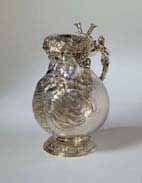Silver treasures
dal 8/6/2002 al 25/8/2002
Segnalato da
8/6/2002
Silver treasures
Lacko Castle, Lacko
It will mark the first major exhibition in this country for more than a century of Swedish silverwork from the great-power era. About 200 items borrowed from Sweden's most prominent silver collections - among them Nationalmuseum's own - display the glory of baroque silver art in all its forms.

Silver treasures from Sweden's great-power era
a summer exhibition at Läckö Castle
After a lengthy, co-operative effort in refurnishing Läckö Castle with its
gorgeous baroque inventory, Nationalmuseum, the Läckö Castle Foundation and
the National Property Board are exhibiting Silver treasures from Sweden's
great-power era, 9 June - 25 August 2002.
It will mark the first major exhibition in this country for more than a
century of Swedish silverwork from the great-power era. About 200 items
borrowed from Sweden's most prominent silver collections - among them
Nationalmuseum's own - display the glory of baroque silver art in all its
forms. The goal is to present Swedish silverwork and its links with
principally German and French silver. The years 1647 and 1721 'bookend' the
exhibition. The starting year, 1647, marked the inauguration of Sweden's
first embassy in Moscow. The period ended with the Peace of Nystad in 1721
(signed with Russia, following similar agreements over three years with
England/Hannover, Prussia and Denmark), which reduced Sweden's position as
the leading power in the Nordic region. The time span is concurrent with
Läckö Castle's own period of glory.
H.M. King Carl XVI Gustaf, the Royal Collections, the Royal Armoury, the
Hallwyl Museum, Skokloster Castle, Sweden's National Museum of Cultural
History and many other museums have generously opened their treasure chests
to enable this exhibition to take place. Unique objects - in many cases, not
previously on public display - have been borrowed from churches and private
collections.
The exhibition has five major themes, distributed over five rooms at Läckö
Castle. The departure point is in the time following the Thirty Years' War
(1647 - 1699) when Sweden became a great power. For political reasons -
involving both diplomacy and trade - Sweden's regents would send gifts to
the Russian tsars. A number of these magnificent pieces are included in the
exhibition. Also shown is ecclesiastical silver made by the finest German
and Swedish silversmiths, as well as a presentation of their craft and
guilds. Marvellous silver objects give us an idea of the private treasures
of contemporary people of rank. The exhibition also has royal and official
silverware, charting the emergence of the French style.
A generous gift from Lidköping's Sparbanken Foundation
Lidköping's Sparbanken Foundation is to support the establishment of a
silver and treasures chamber exhibit at Läckö Castle. The chamber will be
add to the number of permanent attractions at the castle and is itself a
spectacular extension of the lengthy investment in refurnishing Läckö
Castle. As a first step, Lidköping's Sparbanken Foundation purchased six
silver pieces at a cost of SEK 570,000 (ca. $56,000) at the 2001 Autumn
Auction at Bukowski's in Stockholm. The pieces will be part of the
state-owned art collections at Läckö, for which Nationalmuseum has
responsibility, and will also be included in the temporary exhibition,
Silver treasures from Sweden's great-power era. Thus, the summer's
exhibition at Läckö Castle can be seen as an exclusive appetiser for the
coming silver and treasures chamber.
Nationalmuseum provides and is responsible for the art collections at Läckö
Castle; the Foundation manages the castle and the National Property Board
looks after the interiors and exteriors.
Opening hours for Läckö Castle: 1 May - 30 September 2002 daily between 10am
- 6pm (Please note: the Castle is closed on 8 June.). Guided tours daily.
Läckö Castle is situated in the Eken Archipelago, just over 20km north of
Lidköping.



